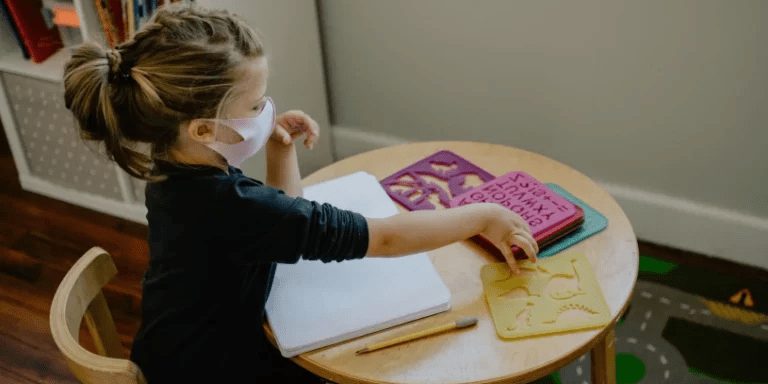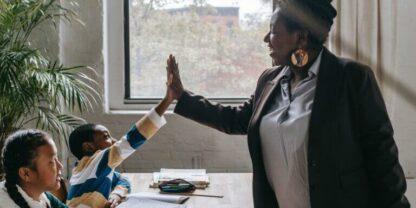The first day of school is exciting for kids, teachers, and parents. A fresh year holds so many possibilities, from making new friends to learning cool facts. However, some students might be nervous when entering a new space. First Day of School activities are a great way to break the ice. You can get to know your students while they learn about each other. These activities can also make kids more comfortable in their new classroom and with their new teacher. Here are more than 20 activities to consider for your classroom.
Welcoming Students
1. Greet Your Students at the Door
Every child wants to feel safe, welcomed, and valued. This activity doesn’t cost you anything and creates a bright first impression. Greet your students at the door and introduce yourself and ask them to introduce themselves. Share how glad you are to see each student and how excited you are about the year ahead. A bright smile from you can wipe away any back-to-school nerves.
2. Create a Class Puzzle or Quilt
If you haven’t had time to decorate your classroom, use first day of school activities to let your students help. Print out large puzzle pieces that come together to form a circle or similar shape. Ask each student to decorate a puzzle piece and include their name in the designs. Then work as a class to put the puzzle together and hang it on the wall. You can also create a class quilt if you only want to work with squares.
3. Read a First Day of School Book
There are dozens of good books you can pick for the first day of school. Even if you teach older elementary school students, they can never outgrow being read to. Choose from direct topics like A Letter From Your Teacher on the First Day of School by Shannon Olsen or establish a theme for the year by reading The Circles All Around Us by Brad Montague. By making reading one of the top first day of school activities, you can excite students about books throughout the year.
4. Lead a Guided Meditation
There is a lot of newness on the first day of school and it’s easy to get overwhelmed. There are so many stimuli, from bright colors to loud students. Some kids might feel anxious in the new setting and stressed about the school year. Turn off the lights in the classroom and bring your students through a guided meditation. Let them focus on calming strategies and breathing exercises. After the meditation, ask your students if they feel calmer and explain that this is a technique they can use whenever they need help focusing.

Get to Know Your Class
5. Ask Kids to Create Name Tags
It’s going to take some time to get to know each student. For now, ask them to create and wear nametags in the classroom. For younger students, write the names yourself and then ask the students to decorate them. Older students should be able to write their names legibly while adding personal flair. You can place stickers, stamps, and markers in the classroom to inspire your students’ decorations.
6. Fill Out “Get to Know Me” Forms
Hand out forms on the first day of school that ask basic questions about your students. These can include where they were born, what foods they like to eat, what animals they like, and other fun facts. Consider turning this activity into a game once the forms are filled out. For example, challenge students to find their peers that all like the same color. Ask students to find a peer who was born in a unique place. This way your kids get to know each other.
7. Tell Students About You
You can also fill out a form highlighting interesting facts about yourself. However, take this a step further so your students can learn about you. Spend a few minutes introducing yourself and sharing information students might want to know. You can even open the floor to answer any questions students have about you before the year starts.
8. Explore Student Learning Styles
You will better understand how your students learn over the course of the year, but you can also ask them for insight on the first day. Create a sheet with a series of agree or disagree statements regarding learning. For example:
- I prefer to sit close to the front.
- I prefer to work in a quiet setting.
- I like listening to music when I work.
- I prefer to work alone.
- I prefer to work with a partner.
These surveys can help you structure your classroom and develop lesson plans for different learners. You can see what the majority of students prefer when it comes to studying.
First Day to Last Day Activities
9. Make First Day of School Wishes
Hand out slips of paper and ask students to write down their hopes for the year. This could be a wish for the year ahead or a goal that your students want to work toward. Place these wishes in a box and tuck them away for the year. You can read them to the class on the last day of school to see which goals were completed and which wishes came true.
10. Write Letters to Their Future Selves
If you are looking for a writing activity for older students – one that is more advanced than making a wish – consider asking students to write letters to themselves instead. They can write about their hopes for the coming year, their favorite subjects, and who they are excited to sit next to. You can hand out these letters at the end of the year so students can see how they changed from the fall to the spring.
11. Measure Your Students
Another activity you can do on the first and last day of the year is to measure your students. Roll out a piece of paper along the way and measure each student, labeling the height and name of each participant. Then fold the paper and save it for the last day of the year, when you can measure the students again. Your students might be surprised at how much they grow over a single school year!
Classroom Management
12. Ask Students to Create Classroom Rules
Students are more likely to follow classroom rules if they actively created them. Instead of relying exclusively on your authority, you can invite your students to agree on classroom policies. For example, how should a student ask to go to the bathroom? How can students sit on a reading rug without tripping others? Chelsea at Long After the Bell Rings created a useful guide for establishing rules in your classroom.
13. Act out Skits Related to These Rules
Once you have a clear set of rules in your classroom, break your students into groups to reinforce them. Each group can develop a skit featuring what happens when they follow and don’t follow the rules. This can help your students better remember the classroom policies.
14. Set Up a Scavenger Hunt
Another way to introduce students to your classroom and the rules that come with it is to create a scavenger hunt. Ask students to find the bathroom pass, hand sanitizer, pencil sharpener, and other areas in the room. To prove they found it, place a secret word next to each area and ask students to write a sentence with the words they find. You can also place stamps next to each scavenger hunt item so students can stamp their worksheets as they navigate the room.
15. Set Aside Dedicated Reading Time
If you want to prioritize reading in your classroom, then it should be part of your activities for the first day of school. Show students where they can find books in your classroom and ask them to each select one to read. Then set a timer and enjoy a silent reading period where students can focus on the books they chose. Make this a habitual part of your school week.
16. Share Advice from Previous Students
There are multiple ways to make this part of your first day of school activities. If you plan carefully, you can ask your students at the end of the year to write advice to the next group of students on cards, then share these with the new batch of students on the first day. You can also ask to borrow a few of your former students during the day and ask them what advice they would give students to succeed in your class.
Ice Breakers
17. Set Up Team-Building Activities
There are several team-building activities for the first day of school that you can choose from in the elementary school classroom. One example is the blanket switch game. Break students into groups and have each group stand on a blanket or beach towel. Challenge students to flip the blanket over without touching the floor, which means they need to work together and build a plan to flip it. You can play multiple games and change up the groups each time so your students get to know each other.
18. Create “Frienn Diagrams”
The Frienn Diagram activity is often used in conflict resolution, but it can also be used as an ice breaker. Pair students together and ask a series of questions. Your students can fill out the diagrams with what they have in common and what they don’t. (These activity sheets are Venn diagrams but for friends.) This activity highlights how it’s okay to have differences and shows how two people who are seemingly unalike can find common ground.
19. Play “Would You Rather”
Provide two options for your students and let them choose the one they prefer. It sounds simple, right? Take this ice breaker to the next level in a way that gets students moving. Ask them to stand on a center line and then crab walk to the left if they would rather have ice cream or to the right if they would rather have cookies. Then ask everyone to return to the center. Keep going through different choices as kids hop, crawl, wiggle, run, and slide to different sides of the room.
20. Ask About Summer in Equitable Ways
Oftentimes, teachers use summer vacation talks as fun ice breakers for students. However, these questions can highlight financial inequities in students – something your less wealthy students don’t want to be reminded of. While some of your students took cruises to Mexico or went to Space Camp, others stayed home and might not have had access to reliable meals, much less summer camp activities.
When you talk about the break period, try to ask questions that any student can answer. Did anyone get caught in a rainstorm? Play with a sibling? See fireworks in a nearby park? The right questions can get almost any student talking.
Bonus: Don’t Forget the Goodbye
Saying goodbye is just as important as saying hello on the first day of school. Set aside a few minutes before it’s time to leave to have a meaningful goodbye with your students. This could involve reciting a See You Later, Alligator poem or challenging each student to provide a unique goodbye as they head out the door (from a high five to a hug). Make sure you highlight how excited you are about the year and how you can’t wait to see your students tomorrow. This can become a classroom tradition.
Set Your Classroom up for Success With eSpark Learning
Your students will arrive eager and ready to learn. Once you get to know everyone, make sure you have the tools to dive right in with resources and activities for the first day of school. At eSpark, we provide an online platform that offers adaptive lessons and differentiated learning, so every student is challenged at an appropriate level. Try eSpark for free today and see how it can be used in your classroom.



